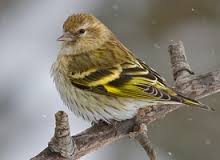An irruption is a dramatic, irregular migration of large numbers of birds to areas where they aren’t typically found, possibly at great distances from their normal ranges. Several factors can lead to irruptive years for different birds. The most common cause is a lack of food in the birds’ normal wintering grounds. Famine can force large numbers of birds to seek more plentiful habitats until seeds, flowers and insects return in the spring. Birds that feed on the seeds and catkins of birch, maple, pine spruce and hemlock trees often irrupt when those types of trees have poor seed crops. Different birds of prey may also irrupt when the seed crops are poor and cannot support the necessary rodent populations for raptor food sources. Other causes for bird irruptions include unduly harsh cold or severe weather that may force birds to more temperate wintering grounds, or over breeding that may further deplete even plentiful food supplies. No matter what the cause of the irruption, however, it is difficult to predict where or when irrupting species may appear.
Many bird species found in boreal and other northern habitats can irrupt if circumstances require it. Certainly, with the recent erratic weather patterns in the East Kootenay and elsewhere, we anticipate unexpected visitors at our feeders. When large numbers of birds appear, it is important to keep birdbaths and feeders clean to keep birds healthy. Provide a variety of fresh, high quality seed and suet. Sometimes, irrupting birds can bully or intimidate other backyard birds, restricting their access to feeders and monopolizing the seed. Birders can change the types of feeders and seed they offer to discourage such behaviour; or they can put up extra feeders to welcome all the new guests to their yard. Spacing feeders out will minimize territoriality and aggression while ensuring all birds can enjoy the buffet.
Bird irruptions can add excitement to winter birding. While birders should never count on an irruption, it can be a pleasant surprise when northern birds appear at southern feeders.
The list:
Irruptive Birds we may see on Count Day
Pine Siskins
Bohemian Waxwings
Evening Grosbeaks
Boreal Chickadees
Pine Grosbeaks
Common Redpolls
Red Crossbills
White-winged Crossbills
Northern Shrikes
Red-breasted Nuthatches
Hoary Redpolls
Varied Thrushes
Great Grey Owls
Snowy Owls
Rough-legged Hawks
Flocks of tiny Pine Siskins may monopolize your thistle feeder one winter and be absent the next. This nomadic finch ranges widely and erratically across the continent each winter in response to seed crops. Better suited to hanging from branch tips than to hopping along the ground, these brown-streaked acrobats flash yellow wing markings as they flutter while feeding or as they explode into flight. Flocks are gregarious, and you may hear their insistent wheezy twitters before you see them. Pine Siskins can temporarily store seeds totaling as much as 10% of their body mass in a part of their esophagus called the crop. The energy in that amount of food could get them through 5-6 cold night hours. The ‘State of the Birds Report’ listed them as a Common Bird in Steep Decline. Domestic cats, red squirrels, hawks, jays and crows can prey on adult birds or on their eggs or young. Pine Siskins’ fondness for mineral deposits can lure them onto dangerously busy roadways salted to remove ice and snow. Loss of habitat from forest clearing may be balanced by replanting and by the Siskins' willingness to nest in shrubs and ornamental trees. It’s good to see the little finches have returned to our feeders.
Feeder watchers are encouraged to help with the Christmas Bird Counts again this year. Keep an eye on your feeders, count the largest number of each species seen at one time and contact us with your list at around 5 PM on Count Day.
Local Christmas Bird Counts:
Cranbrook: Saturday, December 20. Greg Ross, 250 489 2566
Kimberley: Sunday, January 4. Dianne Cooper 250 427 1921
Submitted by Daryl Calder on behalf of Rocky Mountain Naturalists.

 RSS Feed
RSS Feed
